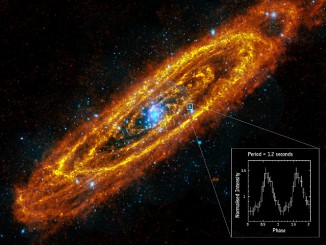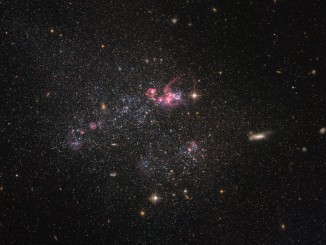
The discovery has been announced by the “Next Generation Virgo Cluster Survey” (NGVS) team and is based on data collected, over the course of 6 years, with MegaCam, a 340-megapixel camera operating at the Canada France Hawaii Telescope and capable of observing, in a single shot, a one square degree field of view (equivalent to four Full Moons). Taking advantage of MegaCam’s wide angle coverage, the NGVS team was able to observe the Virgo Cluster in its entirety, covering an area of the sky equivalent to over 400 Full Moons, at a depth and resolution that significantly exceed those of any existing surveys of the cluster. The resulting mosaic, comprising nearly 40 billion pixels, is the deepest, widest contiguous field ever seen in such detail.
To exploit the full power of the data, Laura Ferrarese, Lauren McArthur and Patrick Cote of the National Research Council of Canada developed a sophisticated data analysis technique that allowed them to discover many times more galaxies than were known previously, including some of the faintest and most diffuse objects ever detected.
Virgo is the nearest large cluster of galaxies, roughly 50 Million light-years away from us. Whereas the Milky Way forms part of a relatively small group of galaxies, the “Local Group”, spread over the nearest few million light-years, Virgo contains dozens of bright galaxies and thousands of fainter ones. In the Local Group, the current theories of galaxy formation suggest there should be hundreds or thousands of dwarf galaxies, but fewer than 100 have been detected. Clusters such as Virgo were known to be richer hunting grounds for dwarfs, but only recently has the NGVS made it possible to set firm constraints on their numbers.
To understand the implications of these new discoveries, Jonathan Grossauer and James Taylor at the University of Waterloo ran computer simulations of clusters like Virgo, to see how many bound concentrations of dark matter they should contain at the present day. Comparing the numbers and masses of dark matter clumps to the population of galaxies discovered by the NGVS, they find a very simple pattern, where the ratio of stellar to dark matter mass changes slowly going from the smallest to the largest galaxies. It seems that in Virgo, there could be a simple relationship between dark matter mass and galaxy brightness, valid over a factor of 100,000 in stellar mass.
This is not the case in the Local Group: the low mass dark matter clumps that would be occupied by galaxies in Virgo, do not seem to have been capable of forming galaxies in the Local Group. So why are the two environments so different? A follow-up study with higher-resolution simulations by the NGVS survey team will explore how galaxies are spatially distributed throughout the cluster, to seek more clues to the mystery of dwarf galaxy formation.



